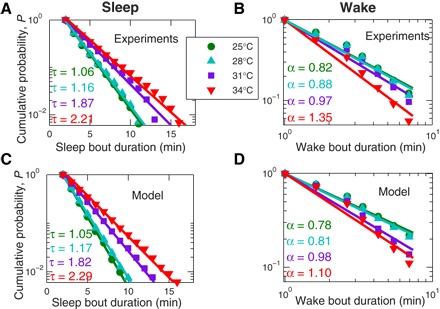Fig. 3. Cumulative probability distributions of sleep and wake bout durations for zebrafish larvae at different water temperatures compared to model simulations with different neuronal noise levels.

Consistent with previous findings (20, 24), sleep bout durations are exponentially distributed with characteristic time scale τ, whereas wake bout durations show a power-law distribution characterized by the scaling exponent α. However, the characteristics of these distributions, τ and α, change with temperature. (A) The characteristic sleep time monotonically increases from τ = 1.06 min at 25°C to τ = 2.21 min at 34°C. (B) The power-law scaling exponent of the wake distributions increases with increasing temperatures from α = 0.82 at 25°C to α = 1.35 at 34°C. These empirically obtained sleep and wake distributions for zebrafish larvae are well reproduced by our model simulations with different temperatures (that is, different values of the neuronal noise level σ: for 25°C ; for 28°C, ; for 31°C, ; and for 34°C, ) that yield the same type of distributions and temperature dependence as the experimental data. Moreover, we obtain practically matching values for τ and α between zebrafish measurements and the model simulations for each temperature and the corresponding noise level σ, consistent with our conclusions from Fig. 2. For all simulations in (C) and (D), we choose the same parameters for the inhibitory current (sleep inertia) coefficient b = 20 mV2/Δt and the excitability threshold (sleep depth) parameter Δ = 10 mV to best match our empirical observations in (A) and (B). Both α and τ values and their SDs (which are of the order 10−2 or lower) were calculated using the maximum likelihood estimation (MLE) method (see Materials and Methods) (41) on the pooled data of all larvae at a given temperature, and these estimates for α and τ are not affected by particular bin selection for the distribution.
